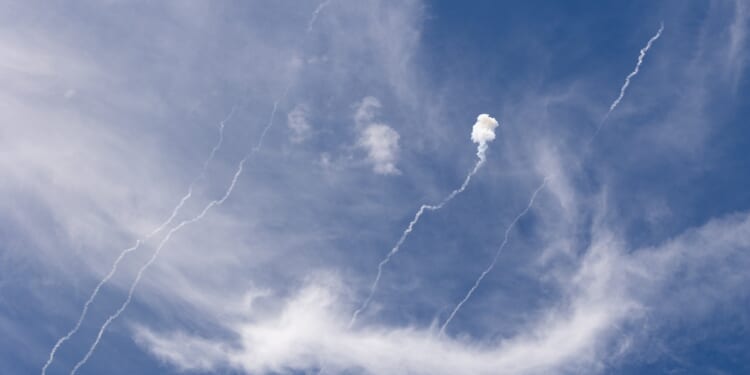The Raven system shows how Ukraine’s backers have moved away from purely conventional, big-ticket, high-end systems to more adaptable and agile improvisational ones.
A British-built air defense system called “Raven” (which has been deployed in Ukraine) has reportedly intercepted three Russian Kh-59 missiles and one Kh-101, along with many drones. The Raven system is adapted from the AIM-132 ASRAAM and is mounted on a vehicle chassis for ground launch. The weapon entered service with Ukraine in the spring of 2023. Since then, it has allegedly engaged more than 400 aerial targets with around a 70 percent success rate.
Initially designed to only counter drones, the Ukrainians quickly adapted the Raven air defense system to defend against both drones and missiles.
The Importance of the Raven Air Defense System
Because of the success of their Raven air defense system, London is authorizing an additional shipment of 350 ASRAAM missiles to Ukraine. To add insult to injury, these weapons are funded by interest on seized Russian assets in Europe. Undoubtedly, that fact is enough to escalate tensions between London and Moscow, as the Russians will not take kindly to weapons destroying their platforms and threatening their troops in Ukraine being funded by their own assets in England.
Yet the Raven system also shows how Ukraine’s backers (primarily the UK) have moved away from purely conventional, big-ticket, high-end systems to more adaptable and agile improvisational ones to meet desperate battlefield needs. Converting air-to-air missiles for ground launch in a few months reflects this. This new system also underscores how the Ukraine War is pushing NATO and its partners into a “learning by doing” mode for air and missile defense.
A core element of Russia’s military strategy in Ukraine thus far has been to use copious amounts of cruise missiles for long-range strikes along with drones in an effort to wear Ukraine’s defenses down. The Raven system attacks that underlying assumption of Russia’s offensive strategy. It’s not necessarily a replacement for heavy systems like the Patriot, but it is designed to complement these systems by filling the last mile defense gap.
Hence, this system could be helpful as more conventional systems, such as the Patriot missile battery, struggle with rapidly declining success rates in shooting down Russian missile swarms.
The Raven system’s mobility (truck-mounted), its infrared seeker (passive), its small signature—all these features make the Raven system useful for Ukraine’s embattled defenders. A big question that arises, just looking at the attrition rate of Ukraine’s gallant forces, is how much longer can Ukraine hold out—even with innovative systems, such as the Raven?
That’s where things get tricky (and nasty) for Ukraine and their NATO backers.
Desperation Is the Mother of Innovation
A recent essay in Defence Blog, a trade publication, indicates that the Raven is increasingly being used for more than just defending against incoming drones and cruise missiles. According to the Defence Blog post the Ukrainians are trying to fire the Raven system at Russian warplanes like the Su-34. Thus, the Ukrainians are desperately trying to adapt newer systems to better fight the Russian onslaught.
The Ukrainian variant of ASRAAM used in ground-launch form is being used in novel fashion; long-term reliability, logistics, vulnerability (to counter-battery fire, jamming, and so on) remain questions. The focus continues being on short-range threats, including heavy ballistic missiles, large drone swarms, or saturation attacks that might still overwhelm (and, in fact, are overwhelming Ukrainian defenses).
Russia will adapt its tactics, as previous iterations of this brutal war have proven. They will likely employ stealthier weapons and platforms against Ukrainian air defenses with lower emissions, firing lower-cost missiles, and utilizing alternate axes of attack.
In the Ukraine War, things aren’t so spit-and-polish. Modern warfare tends to be less Star Wars and more Mad Max. The Raven system is yet another example of the way makeshift defenses are dominating both sides of the conflict.
The question remains: which side’s makeshift weapons overcome the others? Right now, even though the Raven system has proven itself to be vital in this crucial point of the Ukraine War, the Russians continue outpacing their Ukrainian foes.
About the Author: Brandon J. Weichert
Brandon J. Weichert is a senior national security editor at The National Interest. Recently, Weichert became the host of The National Security Hour on America Outloud News and iHeartRadio, where he discusses national security policy every Wednesday at 8pm Eastern. He is also a contributor at Popular Mechanics and has consulted regularly with various government institutions and private organizations on geopolitical issues. Weichert’s writings have appeared in multiple publications, including The Washington Times, National Review, The American Spectator, MSN, The Asia Times, and others. His books include Winning Space: How America Remains a Superpower, Biohacked: China’s Race to Control Life, and The Shadow War: Iran’s Quest for Supremacy. His newest book, A Disaster of Our Own Making: How the West Lost Ukraine is available for purchase wherever books are sold. He can be followed via Twitter @WeTheBrandon.
Image: Shutterstock / Sodel Vladyslav.

















